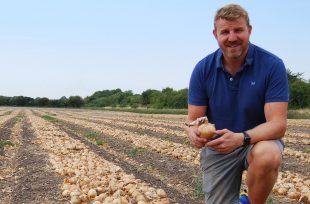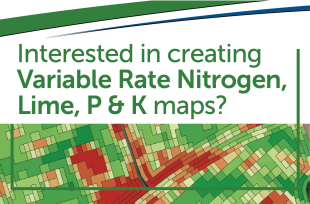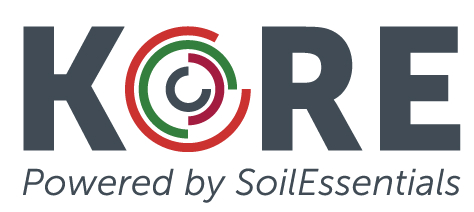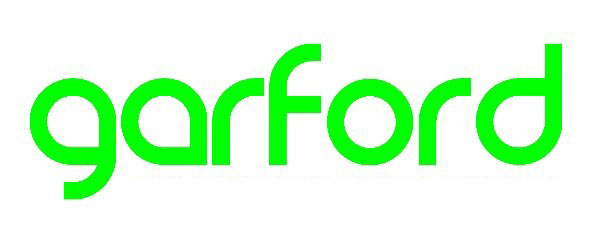This week I presented on findings on PCN and groundkeeper sampling as part of the PCN Action Scotland group project. Funded by Scottish Government’s SASA (Science & Advice for Scottish Agriculture) and in partnership with SRUC, the James Hutton Institute and Scottish Agronomy we held an Open Day at Barnyards Farm, a trial site near Forfar. The impact PCN has, and could further have, on the potato and bulb industry in Scotland is huge and this project aims to have a positive impact on the economic aspect as well as identify control methods which can be implemented to ensure a sustainable future.
High Resolution PCN Sampling
PCN Sampling – Before and after a resistant variety


Example above – 4 samples per ha taken before and after pallida resistant variety was grown
Much lower PCN levels after a resistant variety
• High Resolution PCN Sampling enables:
o Target control measures to where they are needed
o Strips aligned with direction of ridging – allows small field areas to be removed from production
o Can choose whether to put the field up for certification – reduces fields that are scheduled
o Sample immediately AFTER the potato crop. Allows time for decisions and PCN control measures
How is the level of PCN infestation in a soil sample estimated?
There are 2 main methods for the estimation of PCN levels in a soil sample. The traditional method is to extract the PCN cysts from the soil by sieving and flotation and then examine the extract or ‘float’ for cyst nematodes using stereo microscopy. An experienced technician can see whether PCN () are present using high-power microscopy. The cysts can be broken open and the number of eggs inside counted to estimate the number of eggs per gram of soil. This is a slow, skilled and expensive method. Alternatively, the amount of PCN in the soil can be estimated by measurement with a Polymerase Chain Reaction (PCR) amplification method. This can be more easily automated and has the benefit of identifying the PCN species present. The PCR results are measured in Cycle Threshold (CT) values which range from 10 (high level of PCN present) to 34 (above which PCN cannot be reliably detected). Most results are in the 20 to 34 range.
What are Cycle Threshold (CT) values and how do they relate to the amount of PCN in a sample?
From 2011 onwards, as a consequence of the introduction of the new PCN Directive from the EU, SASA increased sampling rates from a sample of 600ml of soil from a unit of up to 4 ha to a sampling rate of 1500ml/ha (standard rate) or 400ml/ha if certain “lower-risk” conditions are met. Annual sample numbers increased from <6000 to around 17000. To accommodate the increased volume of samples, the analysis method changed from visual counting and identification of cysts to a PCR presence or absence. The amount of PCN DNA in the sample is now reported as Cycle Threshold values (CT) which is a measure of how much PCN DNA is in the soil sample. CT is the number of amplification cycles required to reach a threshold of DNA in the sample. The CT value starts at 0 and increases with each cycle until the threshold DNA level is reached. If the threshold isn’t reached by cycle 34, then it is assumed that no DNA is present in that sample and it is passed as clear.
As the amount of DNA in a sample doubles with each cycle of the PCR process, a sample producing a CT value of 25 theoretically would have had double the amount of PCN DNA in the original sample compared to one where the CT threshold is reached at 26. There are a number of other factors that may influence this relationship, which is why SASA currently only use the rough categories of quantification: Low, Medium and High.
How does the CT value relate to the number of cysts or eggs in the soil sample?
It’s difficult to exactly estimate the relationship between a CT value and the number of cysts and eggs in the soil. This is because the number of eggs in each cyst varies between 0 and 400 which leads to a large variation in the level of PCN DNA in a soil sample per cyst. However, as the main threat is from the number of eggs in the sample, the CT value is generally a good estimate of the PCN risk, particularly considering the errors associated with sampling field populations of PCN.
How much soil do you need to take to be sure of the PCN results?
If PCN is uniformly distributed thought the field, then one sample will get the correct result 100% of the time. But most things in agriculture aren’t evenly distributed – pH, yield, grain protein, etc all change spatially across the field (and over time.) Therefore, the number of samples you need to take is dependent on how variable the distribution of PCN is across the field, how confident you need to be of the result, how many sub samples are taken and volume of the sample. PCN is a very difficult sampling problem due to these factors.
Most infestations in Scotland are quite “young” in that they have only been in the field for 3 to 5 potato crops, so they tend to be very clumpy with hotspots. Older infestations tend to be more uniform as they have had time to spread across the field – so are easier to detect. For seed you need to be confident that you have detected any that are there (as there is a NIL tolerance for seed production) but without testing every gram of soil in the field you can’t be 100% sure you have found the infestation.
So to detect the hotspots you need to take as many samples as possible, from as many places in the field as possible, with as much soil as possible. However the more samples you take, the more cost and you can NEVER be 100% certain of finding a low level of PCN. (You can never be 100% certain of finding a high level of PCN either, but at least the odds are in your favour…)
Below is a table that can be used to work out the likelihood of detection of a PCN infestation. You can see that to achieve a 92% confidence of detection at 3.8 million cysts per ha (quite a lot) you need 1500 ml. For 750k cysts per ha @ 90% probability you need 10,000 ml. However these are just best estimates as each field infestation pattern is different.

Groundkeeper Detection – Drone Imagery


• Many carrot fields had a major groundkeeper infestation
• Most carrot fields in a rotation with potatoes
• Images are georeferenced to within 10cm (uses RTK)
• So each groundkeeper is accurately georeferenced and we can navigate back to that location in the future
• These flights were used to target soil sampling for PCN close to and 1 metre away from groundkeepers
• In this experiment, over the initial 34 pairs of samples, provisional results suggest that the presence of groundkeepers increases the amount of PCN in one growing season when compared to a paired sample 1 metre away
• The average increase was 16 times
• In the 33 pairs where the PCN increased due to groundkeepers, the increase varied from 2 times to a 500-fold increase
• In 33 of the pairs of samples, the amount of PCN increased, only in 1 pair did the PCN decrease
• This highlights the importance of groundkeeper control
Real Time Detection and Spot Spraying – Weeds and Groundkeepers
SKAi


Provides a re-trainable machine vision platform for agriculture
Means that we can target any problem
Developed a web tool that allows users to take images of a problem they wish to solve
Can label the images online
Train and test a model based on the labelled images
Send the model to the AI system on the sprayer
Sprayer spot treats the problem in the field
Only spays the problem weed – 90% saving
Maps the weed distribution
Can target groundkeepers for real time control
High resolution spot spraying
50cm -> 25cm -> 10cm -> below?
Target groundkeepers in many crops
Non-chemical control?
We have had a huge loss of effective chemistry
This will hopefully protect remaining tools
Other controls? Mechanical / laser / biological
Autonomous vehicles
Ideal partner for machine vision
18 August 2022 Latest from the Directors

Featured Case Study
Angus Bryce, D Bryce & Sons
Find out more
Featured Case Study
Tim Young, JS Young Farms
Find out moreSave on costs by targeting your inputs to soil types and conditions.
Use our precision farming platform, eligible under the new SFI scheme in England!
Find out moreUse KORE, our independent precision farming platform to improve your client management, increase efficiency and enhance your agronomy and soil sampling services.
For more information call the office on 01356 650459 (option 1) or Ed on 07425 338545.

For XCN, GFX, NAV 900 and other Trimble RTX displays
Renew your RTX subscription from £260pa*
Find out moreIf you're feeling the winter blues about your RangePoint RTX renewal, warm up with a new subscription from only £260 pa*
SoilEssentials are your longstanding, independent Trimble authorised dealer in Scotland and Northern UK.
To renew your RangePoint RTX subscription call the office on 01356 650459 (option 1), Rod on 07824 617153 or Bob on 07827 480056.
*Ts&Cs apply. Price applies to a 5-year upfront contract. Open to all RTX customers.











